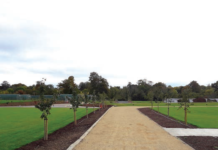Landscape estimating specialist, Colm Kenny explores the reality of landscape labour costs and sets out some simple rules to increase profitability
I am always bewildered and sometimes a little frightened when I get tenders back on projects to analyse. The variance in returned tenders for even the smallest of projects can range from 1 % to twice the price of the lowest tender. When I am going through the process of reviewing these tenders I question if they are all looking at the same project. All contractors received the same tender package containing the project drawings, specification and other information, yet all are on a different page when it comes to pricing it.
Unlike general construction schemes, there are not too many diverse elements involved in landscape projects. Items such as the proposed paving are generally specified by the manufacturer, right down to the colour so we all know where to buy them, and generally, all contractors are buying them at the same price. Likewise, the trees, plants and sundry soft landscapes materials. The question remains how such a difference in tender returns prices vary from one contractor to another. Granted, contractors’ pricing strategies are unique. However, the differences can’t be explained by this alone. So, if we can assume that the cost of the materials is to a certain degree consistent, the difference in tender returns comes down to the other two elements in a pricing formula: the cost of labour and contractors’ profit.
It might appear that an employee’s hourly rate is simply the wage he receives for each hour he works. That amount, however, is only part of the real cost. The real cost includes employer’s PRSI, employee benefits and direct labour costs. Items which are often forgotten about are holidays, sick leave, training costs, pension contributions, health insurance, training costs and uniforms. Knowing your employee’s true hourly rate facilitates accurate estimating and helps you reach your profit objectives. There are many online calculators which can assist you in accurately calculating the cost of your workforce.
It is vital that the cost of each staff member is known as the staff are often set up as a crew, which adds another variable to costing each project. When tendering it is important you allocate the most appropriate crew to the project. Three elements that influence the cost of labour are the type of crew, the production rate for the specified crew, and the pay structure. A crew generally consists of specialised and nonspecialised members. A typical landscape crew can include laborers, skilled workers, and machinery operators. Additional classifications of workers may be required depending on the complexity of the project. Each task may require a different type of crew. For example, irrigation may require a crew of two skilled workers, whereas trenching may require a labourer and a digger driver to excavate the trench.
Each specific task will require a certain crew, and that crew will have a combined crew rate that is based on an hourly or daily rate. When applying the specified crew rate to the quantity and unit of measurement, a production rate is used to indicate how much or how many of a specified task is accomplished by the crew in a specified time. For example, a trenching crew may have a production rate of 30m of trench per hour. The production rate would, therefore, be 1m every two minutes. Every element of the project can be and should be calculated in this way.
Often contractors fail to add traveling time to the cost of labour. Employees get paid from the moment they arrive at the yard in the morning until they close the gate in the evening. Most staff are on a standard weekly wage and may only get extra wages if they work on a Saturday. However, the cost of having staff with their heads in the phones traveling to site is a cost which needs to be paid and therefore factored into rates. Contractors who are competing for a tender far away from their base should, in theory, be at a disadvantage as a local contractor will, in theory, have a competitive advantage as traveling time and other costs associated with transportation of machinery and materials are lower. However, my experience is they don’t seem to consider the additional costs. Even for someone like myself who only needs a pen and a calculator with no machinery to transport to site or staff accompanying me in the car. If I must factor all this into my rates, contractors certainly must factor in all the above.
While traveling time is somewhat easy to factor in and a science can be put behind it, hours associated with the unexpected stand down time or inefficiency are more difficult to calculate and rely more on experience. Think about time lost to weather, restrictions imposed by main contractors or planning permissions, unavoidable holdups and disruptions to normal workflows. Some causes of inefficiencies, if known and earmarked by the design team at tender stage, are identified; these costs can be accounted for in the cost of preliminaries. A straightforward example of this would be working times. Here, the works requirements document states that works can only be carried out between 10 am and 3 pm, this would obviously have implications on the additional resources that may be required to keep the budget on programme, such as more manpower, more supervision, and more office costs. These can all be accounted for in the preliminaries. Unforeseen items such as the weather or bad hair days come down to past experiences. Most contractors are afraid to include money to cover this risk for fear of losing out a project, but they should as such days can be the difference between a successful project and a failed one.
Once you have the cost of materials and the real cost of labour calculated for every specific project, you need to look at profit and profit margins. Profit can be defined as the money the project makes after accounting for all costs and expenses. The percentage profit a contractor might apply to their tender price will vary according to risk, workload and economic climate. Every expense in your business takes a little bite out of the profit of a job and of course, you want to maximise your profit and bottom line, because that’s what business is all about. We are not all here to make friends, if you are like me you probably have enough of them. It is profit that makes the world go around and probably the main reason why most business owners started out on the rollercoaster journey of steering their own ship.
Again, there are a few different techniques to calculate this. The one which I think most contractors use, whether it is intentional or a habit, is the top-down approach. This method involves you asking yourself, ‘What is the market going to let me get away with in terms of pricing?’. Work backward from that, figuring in expenses as outlined above. What you end up with is a profit margin, though not necessarily the target profit you might have in mind. I don’t think it is the best method to use as it is not necessarily very accurate.
I would encourage contractors to calculate the cost of doing business in a similar fashion to calculating the cost of labour. Overheads should be priced proportionately against a project and are the calculated costs of running the company contracted to carry out a project. Often these costs are described as head office administrative costs. Head office costs might include property costs, finance charges on loans, insurances, office staff, external advisors, marketing and tendering costs. Typically, and from the contractors, I have worked with over the years, most will calculate a percentage against project costs to be set against each project somewhere between 5% and 15% to cover head office services. I am not telling you that this is what your profit margin should be as every single landscape contractor will have different cost but as a benchmark, it is probably not a bad guide.
Finally, you have submitted a price for the job having worked out the true cost and included a sustainable profit margin which will allow you to stay in business. After handing in the tender, the potential client calls you claiming they have found a competitor who can do the job for 10% less. They explain they enjoyed the experience of working with you on a previous job and would rather have you do the job, so could you please match that price? What do you do? It can look attractive to discount and beat the competition on price. It is money in the bank, food on the table and 10% seems a small amount to slice off the end price. But, a discount of 10% can wipe out a business. Fair enough, most contractors will be able to withstand offering a discount once but long term you can kiss the business goodbye.
Each time you or someone else undercuts the competition, the trades industry becomes just that little bit smaller. By competing on price, you are racing your competition to the bottom. In the end, something has to give, whether it is work quality, staff turnover or running out of cash. The client is the only one benefiting, be it the main contractor or a private homeowner.
Clients will always want to pay the least possible in principle, but will often pay more when they perceive value. The high quality of work and great client experience are both important ways to offer value. Clients will find a way to pay more if they feel they get some value in return. Value also comes in other forms such as quality, speed, convenience, being nice to deal with and being reliable. The job of any shrewd business owner is to find a value proposition that fulfills a need of their clients. Unless the business is well-funded, if your strategy is to undercut the competition, you’re operating an unwise business strategy that has brought many a business to its knees. Offering that discount might look tempting when it means winning a job, but if you take it you’re only selling your business short. ✽
 COLM KENNY, MSCSI MRICS MILI is unique in Ireland in that he is both a chartered quantity surveyor and a Landscape Architect. He provides cost consultancy services to landscape industry professionals, technical advisors, contractors and facility management companies. He can be contacted on 086 874 4300 or by email info@landscapeqs.ie COLM KENNY, MSCSI MRICS MILI is unique in Ireland in that he is both a chartered quantity surveyor and a Landscape Architect. He provides cost consultancy services to landscape industry professionals, technical advisors, contractors and facility management companies. He can be contacted on 086 874 4300 or by email info@landscapeqs.ie |







